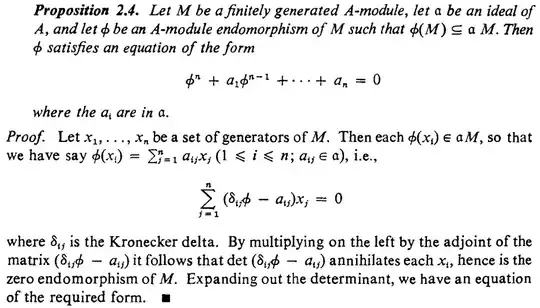I'm struggling here with the proof. To be honnest i need a really concrete explanation because i have been on it for a long time and i can not find it nowhere else.
 Please can anyone help me with this?
And thank you in advance.
Please can anyone help me with this?
And thank you in advance.
I'm struggling here with the proof. To be honnest i need a really concrete explanation because i have been on it for a long time and i can not find it nowhere else.
 Please can anyone help me with this?
And thank you in advance.
Please can anyone help me with this?
And thank you in advance.
Consider the commutative subring $R=A[\phi]\subset\mathrm{End}_A(M)$ generated by $\phi$; then $R$ acts on $M$, and thus $M_n(R)$ acts on $M\oplus\cdots\oplus M$, the direct sum of $n$ copies of $M$. The equations $$\phi(x_j)=\sum_{i=1}^na_{ij}x_i\,,$$ for $j=1,\dots, n$, can be reinterpreted with the action of $M_n(R)$ on $M^{\oplus n}$: write $$B=\begin{pmatrix} a_{11}-\phi & a_{12} & a_{13} & \cdots\\ a_{21} & a_{22}-\phi & a_{23} & \cdots\\ a_{31} & a_{32} & a_{33}-\phi & \cdots\\ \vdots&\vdots&\vdots&\ddots \end{pmatrix}\in M_n(R)\qquad\text{and}\qquad X=\begin{pmatrix}x_1\\x_2\\\vdots\\x_n\end{pmatrix}\in M^{\oplus n}$$ (To be very precise, we shoud actually write $a_{ij}\mathrm{id}_M$ everywhere instead of $a_{ij}$). Then the $n$ equations we wrote at the start are equivalent to the one equation $$B X=0$$ Since $R$ is commutative, we have $\mathrm{Adj}(B)\times B=\det(B)I_n=B\times\mathrm{Adj}(B)$, which is an equation which holds in $M_n(R)$. If we multiply the previous equation on the left by $\mathrm{Adj}(B)$, we get that $$0=\mathrm{Adj}(B) B X=\begin{pmatrix}\det(B)\\&\det(B)\\&&\ddots\\&&&\det(B)\end{pmatrix}\begin{pmatrix}x_1\\x_2\\\vdots\\x_n\end{pmatrix}=\begin{pmatrix}\det(B)x_1\\\det(B)x_2\\\vdots\\\det(B)x_n\end{pmatrix}$$ Since the $x_i$ generate $M$, this is equivalent to saying that $\det(B)$, which is an element of $R$, hence an endomorphism of $M$, is the zero endomorphism of $M$. The determinant $\det(B)\in R\subset\mathrm{End}_A(M)$ can be calculated by the standard formula $$\det(B)=\sum_{\sigma\in\mathfrak{S}_n}(-1)^\sigma\prod_{j=1}^nB_{\sigma(j),j}$$ which, upon inspection, is polynomial in $\phi$ of degree $n$ with coefficients in the ideal $\mathfrak a$. The coefficient in front of $\phi^n$ is $(-1)^n$, and since $\det(B)=0$, you get a relation $$\phi^n+a_1\phi^{n-1}+\cdots+a_{n-1}\phi+a_n\mathrm{id}_M=0$$
I will assume that you are fine up to equation
$(1): \, \sum_{j=1}^n (\delta_{ij} \phi -a_{ij} ) x_j=0, \, \, \, i=1,\dots,n$.
These equations can be represented in matrix form as
$(2): \, \boldsymbol{C} \boldsymbol{x}=0$, where $\boldsymbol{x}=(x_1,\dots,x_n)^\top$ and $\boldsymbol{C}$ is an $n \times n$ matrix with $\boldsymbol{C}_{ij} = \delta_{ij} \phi -a_{ij}$.
If you wonder why (2) makes sense, note that the ring of endomorphisms of $M$ acts on $M$ in a way such that $M$ is an $\operatorname{End}_A(M)$-module. If you multiply from the left equation $(2)$ with the adjoint of $\boldsymbol{C}$, you will get
$(3): \, \boldsymbol{C}^{\dagger} \boldsymbol{C} \boldsymbol{x}=0$.
But matrix algebra extends to matrices over commutative rings (see Serge Lang's "Algebra" for this) and the well-known relation
$(4): \, \boldsymbol{C}^{\dagger} \boldsymbol{C} = \operatorname{det}(\boldsymbol{C}) I$
still holds (again see Lang). Substitute this into $(3)$ and get that
$\operatorname{det}(\boldsymbol{C}) \boldsymbol{x} = 0$, which implies that $\operatorname{det}(\boldsymbol{C}) M=0$.